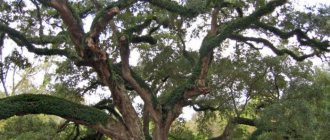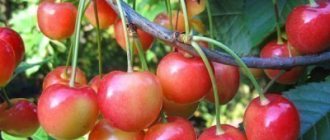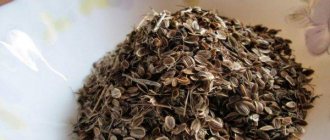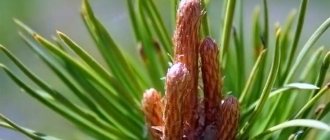Pine lifespan
There are hundreds of varieties of pine trees in nature, many of which are long-lived.
How many years a pine tree lives depends on its species, growth zone, environmental situation and a number of other factors. In most cases, the longer a tree is able to grow, the longer its lifespan. Ornamental varieties that reach 2 meters die after a few decades, while pines that grow to 20 m or more can live for many centuries.
How long does Scots pine live (grow)
Scots pine is a common species that is found in almost all coniferous forests of Europe, the Balkans, and also in the taiga in Russia. How long a pine tree grows depends on the subspecies of the tree and the area where it lives.
In harsh climate zones, where winters are long and favorable periods are short, trees grow more slowly, which increases their life expectancy. In most cases, active growth lasts no more than 40 years. Subsequently, it slows down greatly, but at the same time the formation of the crown, strengthening of the trunk and skeletal branches, as well as the growth of the root system occur.
The common pine in the Siberian taiga rarely lives more than 500 years. In the protected forests of Europe, where the climate is milder, ordinary pines can grow for more than 2 centuries, reaching gigantic sizes.
When is it necessary to uproot old trees?
Trees are the lungs of our planet, which is why it is so important to preserve green spaces as much as possible. Unfortunately, sooner or later any tree ages and dries out irrevocably, and it has to be uprooted.
Of course, owners of private houses try to keep trees alive for as long as possible by carrying out anti-aging pruning and proper care. But, if these procedures do not help, it is better to cut down the old trunk and plant a new young tree instead.
What does longevity depend on?
Human activity has the most detrimental effect on coniferous forests. The oldest pines are found in protected areas where logging is prohibited by law. In addition, large equipment is prohibited from passing through such areas, so tree roots are not damaged and they can live longer than in areas where forests encounter human activity.
In other places where pine grows, the lifespan of which can reach an average of 200-300 years, it is cut down after reaching an age where the wood can be used for lumber. How long a pine tree lives depends on the influence of such unfavorable factors as:
Conifer resin has a powerful bactericidal effect, so they rarely die from infectious diseases. In addition, it is extremely rare for specimens that grow for many years in established old forests to die from the influence of insects that feed on wood and animals.
It has been noted that pines living in cold climates reach a greater age than those growing in warm environments. Good conditions for conifers are average temperatures and moist soil.
In the northernmost regions, where temperatures drop to critical levels and too strong winds blow, pines grow up to 2-3 m and often have curved trunks. Under such conditions, the lifespan of trees is greatly reduced. Young specimens quickly die from frost, lack of light and water. At the same time, some ancient species of pine trees, adapted to life in the highlands, live more than 5,000 years. When growing ornamental varieties in warm climates, their lifespan does not exceed 40-80 years.
Taxonomy
Pinus sylvestris
, 1753, Species Plantarum 2: 1000[5].
Synonyms[6]
- Pinus binatofolio Gilib.
- Pinus borealis Salisb.
- Pinus cretacea Kalen.
- Pinus ericetorum Thore
- Pinus erzeroomica Calvert ex Gordon
- Pinus fominii Kondra.
- Pinus frieseana Wich.
- Pinus genevensis Carriere
- Pinus genovensis Garsault
- Pinus hagenaviensis K.Koch
- Pinus krylovii Serg. & Kondra.
- Pinus lapponica (Hartm.) Mayr
- Pinus montana Hoffm.
- Pinus mughus Jackq.
- Pinus resinosa Savi
- Pinus rigensis Loudon
- Pinus rubra Mill.
- Pinus tartarica Mill.
Varieties
In different parts of the range, scientists have identified varieties of Scots pine, as well as morphological and ecological forms - ecotypes, which are characteristic of certain areas of growth.
Currently, scientists are considering 3 valid subspecies of Scots pine:
- Pinus sylvestris var. hamata Steven - grows on the Balkan Peninsula, in northern Turkey and Transcaucasia, at an altitude of 500-2600 m above sea level.
- Pinus sylvestris var. lapponica - grows in Norway, Sweden, Finland and adjacent territories of Russia north of 65° north latitude (northern Karelia and Murmansk region). On the Solovetsky Islands in the White Sea, its growth is up to 30 m [7]. The needles are shorter and stiffer. The seeds are yellowish-brown. Often forms a shrubby creeping form[8].
- Pinus sylvestris var. mongolica Litv. - grows in Mongolia, northwestern China and southern Siberia, at an altitude of 300-2000 m above sea level. It occupies large areas in Transbaikalia; in other places it prefers dry and sandy soils. In the Sokhondo Nature Reserve in Transbaikalia, a tree grows 42 m high[7].
Ecotypes
Due to the wide range of Scots pine, extending over significantly ecologically different areas, this species is characterized by a very significant number, up to 30, ecotypes identified by ecologists. For example, Angara pine, an ecotype of Scots pine, grows in the Angara River basin.
The formation of distinctive ecotypes in natural conditions contributed to the emergence of a large number of scientific names synonymous with the species, which currently have the status of nom. illeg. or nom. inval. and are not used in taxonomy.
How to determine age
When cutting, you can find out the exact age by examining the cut and counting the number of rings. You can roughly determine how old a tree is without sawing. If the height of the trunk is more than 40 m, it means that it is already more than 15-20 years old. Until this mark is reached, the growth is 50-100 cm, then it slows down, thus, only the minimum age can be determined by this parameter.
Some foresters can determine the age of a tree by the number of thickenings on the trunk. However, this method is not very reliable, because... Such formations in most pine species appear only at a young age.
Determining the age of a tree by annual rings and indirect signs
Any tree is a living organism, it grows, eats, breathes. But there are a number of features that distinguish it from other living beings (for example, a person or an animal).
And the main one is the ability of it, like other plant organisms, to obtain organic substances from inorganic substances using photosynthesis - the process of converting the energy of solar radiation.
Fruit trees
Another feature is the growth process. Trees grow not only in height, but also in width. The increase in diameter of the trunk occurs due to the cambium - educational tissue that “deposits” living cells on both sides of it - inward and outward.
The cells located inside the trunk form wood - the main material. The cells created by the cambium outward from the center of the trunk form the phloem. This is the living inner part of the bark that allows movement and transfer of nutrients produced by the leaves to the root system and young growing shoots.
In the spring, when plant growth and the process of nutrient absorption are activated, the cambium produces a large number of conducting cells - wide with thin walls. In autumn, the growth process slows down, the newly formed cells become narrower, and their walls thicken.
Thus, over the course of a year, a ring appears with an inner light part, formed in the spring, and a darker outer part, which grows in winter. The age of the tree is often judged by the number of such rings visible on the cut of the trunk. The alternation of light and dark layers of wood sometimes allows you to determine the number of rings even with the naked eye. To obtain more accurate data, use a microscope.
READ MORE: Cold welding for cast iron heating radiators mastix and something else
Coniferous trees have growth rings that are clearly visible to the naked eye. The woody tissues of some deciduous trees (linden, willow, birch) have rather narrow cells, so their growth rings are poorly distinguishable. When studying such trees, special coloring compounds are used to distinguish the boundaries of the rings.
Tree rings can be used to determine not only the age of trees. Their color, density, width allow us to draw conclusions about the weather conditions that affected the plant, the pests that attacked it and other natural processes.
Weeping willow
To count the number of rings, you need to cut down a tree. How to find out the age of a tree without cutting it down? There is another way to calculate how long the tree will live. True, it is not particularly accurate. To determine the age of the plant, the number of whorls is counted.
The number of whorls located at a level above the chest of an adult is counted. In this case, taking into account the top of the crown, one is added to the resulting number;
The diameter is divided by the average annual increase in diameter. This value can be found in statistical data; they show average figures for various breeds in a particular area. The result of division will be the desired value.
Thus, the age of a tree can be determined by tree rings or by empirical methods.
The first method is more accurate, the second is used when they do not want to damage the plant, and only an approximate result is needed.
There are several ways by which you can determine the average, and sometimes even the exact duration of the existence of a particular instance.
First, let's focus on a method that involves studying tree rings. The increase in trunk width depends on the growth of the cambium. This is a special tissue that grows both inside and outside the trunk (Figure 2).
The cambium develops unevenly, depending on the time of year:
- In spring, wide cells with narrow walls are formed, since it is through them that the above-ground part of the tree receives a sufficient amount of nutrients. Such fabrics have a light color when cut.
- In autumn, a cambium with thick walls is formed, which makes the wood more dense. Accordingly, such a layer of fabric will have a more saturated dark color.
By counting the number of light and dark stripes, you can determine the number of seasons the tree has lived through. By the way, in the process of studying you can find a dark stripe that is wider than the others. This indicates that the tree has survived a very cold autumn or long winter. Accordingly, such data make it possible not only to determine the age of a particular specimen, but also to find out in what climatic conditions it grew.
Determining age by indirect evidence is not such an accurate method, but it does not involve mechanical damage to the tree. The fact is that to count the rings, the selected specimen must either be completely cut down or seriously damaged. This is not always possible, so scientists quite often use indirect methods. They can also be used at home.
Figure 2. Counting tree rings is the most effective method for determining age.
For example, you can measure the circumference of a trunk one and a half meters from ground level. Then the resulting indicator is multiplied by Pi (3.14) and the trunk diameter is obtained. This figure must be divided by the average annual growth for a given tree species in a particular region. The result obtained will not be completely accurate. In most cases, the error reaches 30%.
You can find out the number of years lived by a living coniferous plant using available means. To measure you will need a measuring tape and a calculator.
Instructions:
- Measure the height of the trunk from the soil surface to 1.5 m.
- Measure the circle at this distance.
- Multiply the resulting figure by 0.7 (the coefficient calculated by scientists).
Dendrologists compiling reports by region have found a way to count the annual rings of a living tree without cutting it down. To do this, on a level part of the trunk without branches, the bark is removed and the core is drilled exactly in the horizontal direction using a tubular, hollow drill. The drill must go through the entire diameter of the barrel.
Important! Coniferous plants form thickenings on the trunk, which experts use to calculate their age. But the method is not very reliable, since whorls form only in the early years.
The wound is treated with resin or a special antiseptic (garden pitch); it heals over time without harming the plant. The growth rings on the extracted piece of wood are counted and divided in two. The resulting amount will be the age of the pine tree.
The oldest pines in Russia and the world
The oldest pine tree in the world is believed to grow in Inyo National Forest in California. She was named Methuselah. It belongs to a rare species of bristlecone intermontane pines. Research has established that her age is 5069 years. Scientists believe that such longevity is the result of the adaptation of this type of conifer to growth on poor soils under extremely unfavorable conditions.
The second place among ancient trees is also occupied by the spinous intermountain variety, growing in Nevada. Her age was 4862 years. It was named Prometheus. The age of this plant was determined after the tree was cut down.
Another bristlecone intermountain pine ranks 3rd among long-lived trees. Its age is 4850 years. It grows in California in the mountains, where environmental conditions are extremely unfavorable and the tree grows too slowly due to low temperatures, lack of nutrients and water.
The age of the remaining long-lived pines is much younger. A bristlecone pine has been discovered in Colorado that is 2,443 years old. In addition, specimens whose age ranges from 1.5 to 2 thousand years have been identified in North and South America.
Australia's oldest pine tree, the Huon pine, grows in the Reed Mountains in Tasmania. This plant lives in fairly harsh conditions. In the mountainous areas where it grows, the night temperature drops to -15°C, and the daytime temperature rises to +40°C. The estimated age is 3-4 thousand years.
In Europe, pine trees that are about a century old have been identified in the Fulu Mountains. Since Europe is the most explored continent, it is believed that many ancient specimens were cut down.
The oldest tree in Europe was discovered in Pollino National Park in Italy. This specimen grows in mountainous areas on soils poor in nutrients. It was named Italus. The approximate age of this pine is 1230 years.
All coniferous forests in Russia are often subject to fires and severe frosts, leading to the death of the oldest and weakest trees. These factors, as well as human activity, lead to the rejuvenation of forests. In the vast expanses of the Russian taiga, it is extremely difficult to find specimens that are more than 200 years old. However, a specimen was discovered in the Urals, the estimated age of which is 420 years.
Which tree has the longest lifespan on Earth?
Valera peace Yao
The oldest tree Long-lived pine (Pinus longaeva) USA, Eastern Nevada 5100 years
Records in the plant kingdom https://www.calc.ru/278.html The oldest oak in Europe is Stemluzhsky. It grows in Lithuania. The oldest trees on Earth are pines (the age of long-lasting or bristlecone pine (Pinis longaeva or Pinis aristata) in California is approximately 4900 years old; other sources are about 6000 years old); such species do not grow in Europe. https://kraj.vitebsk.net/?page=guarding&sod=03 Modern scientists discuss about 300 hypotheses of aging, but they fit well into three main directions. The first group of hypotheses suggests that aging and death are a process inherent in the genome. Obsolete individuals must inevitably give way (space, resources) to their young descendants. Therefore, Nature took care of the continuity of life by placing a special aging program in the genes, that is, an order for self-destruction. The reality of the aging program is confirmed by the existence of a limiting number of cell divisions (Hayflick limit), and the discovery of the telomerase cell division counter. However, P. Yu. Zhmylev reports that plants are unlikely to provide much evidence to support such a programmed cell division counter. At the same time, genes responsible for leaf aging have been found in some plants. The genes for leaf senescence in annual plants, such as sorghum, are located close to the genes for flowering, so it is logical to assume that flowering inevitably entails senescence. This connection, however, is not so unambiguous, since about 30 leaf senescence genes are currently known, which represent a complex regulatory network. And flowering itself is regulated by a significant number of genes and may be completely unrelated to aging, as is typical for rice. Apparently, plants do not have a universal genetic apparatus for longevity. https://elementy.ru/news/430379 Time of life. Some species of Conifers are among the longest-living plants in the world. ——For example, the mammoth tree is such a long-liver; the age of some of its specimens is more than 3000 years, but the longevity record is broken by another species, namely the North American long-lived pine (Pinus longaeva). ——A specimen of this species was found in Eastern Nevada, whose age is estimated at approximately 4900 years, that is, almost five thousand years. This means that already during the construction of the Cheops pyramid this plant was already quite old (it was more than 200 years old). https://www.krugosvet.ru/articles/116/1011696/1011696a2.htm The oldest - The oldest existing species is ginkgo biloba, which lived in the Jurassic period, 160 million years ago. —-The long-lived pine lived the longest - 5100 years - in Nevada (USA). —-The oldest living tree belongs to the same species and grows in the White Mountains of California. This pine is called "Methuselah". It is believed to be about 4600 years old. https://e-lib.gasu.ru/eposobia/botany/00/02/more01.htm FROM THE GUINNESS BOOK OF RECORDS
Ruslan
American sequoia up to 1000 years old and the tallest
Vasabi
I don’t know for sure... but maybe oak?
Nana
Sequoiadendron giant (mammoth tree).
Sequoiadendron giant, mammoth tree - This is a coniferous evergreen tree of gigantic size, native to North America. Once upon a time, 60 million years ago, it was widespread in the Northern Hemisphere, but is now preserved only in a special reserve in the Sierra Nevada mountains in California. The grove has only about 500 trees.
This is one of the tallest and longest-living trees on the globe. In their homeland, individual specimens reach gigantic sizes: 140 m in height and 20 m across the trunk, living up to 4–6 thousand years. Struck by its gigantic size and the peculiar arrangement of huge arched hanging branches reminiscent of mammoth tusks, the discoverers gave it the name mammoth tree.
This unusually majestic and monumental plant was given the names of famous personalities. So, in the USA it is called Washingtonia in honor of the first American president D. Washington, and in England - Wellingtonia in honor of the hero of the Battle of Waterloo, the English Duke of Wellington.
The wood has a reddish-pink color, for which it is also called “Sierra Redwood”. It does not rot and is used in construction to make tiles. The largest sequoiadendrons in the reserve have their own names: “Father of Forests”, “General Sherman”, “General Grant”. The Americans calculated that the General Sherman sequoiadendron contains about 1,500 cubic meters of wood, with a height of 83 m and a trunk diameter at the base of the tree of 11 m. To transport it would require a train of 20–25 cars. An orchestra and three dozen dancers sit freely on the stump of another tree. There are also known tunnels made in the lower part of the trunks, through which cars can freely pass.
Sequoiadendron was discovered by traveler Lobb in 1850, and already in 1858 several specimens were planted in the Nikitsky Garden. A beautiful crown in the form of a clear, regular pyramid, graceful needles and cones, rapid growth and size have made sequoiadendron attractive for the design of parks. Although its seeds have low germination, it propagates well by cuttings. In the Nikitsky Garden you can not only see the oldest and most majestic sequoiadendron trees on the southern coast of Crimea, but also visit a grove of 40-year-old trees obtained from cuttings and already reaching impressive sizes.
Ilnur Khamidullin
baobab
Julius
In America there, Muir Woods, is 70 meters high, 4.3 meters in diameter! They are the oldest trees on earth!!! !
How long do fruit trees live?
Among fruit trees, wild apple and pear trees growing in the forest are the most durable.
In central Russia they can live 100 and 150 years.
Their forest counterparts in Ukraine, where the climate is somewhat milder, can grow longer than this. The first cultivated varieties of apple and pear trees, propagated by seeds, also reached this age.
It is known that such fruits are more durable than grafted ones, or those grown from root shoots or from a stump. How long a fruit seedling will live depends on when it begins to bear fruit.
But the shortest term in the Russian expanses, even in the south, is given to the peach - from 5 to 20 years.
In Turkey and Greece, peach species live much longer, up to hundreds of years, just like apricot. In the Caucasus there are apricot species that are about 300 years old. Cherries and sweet cherries are considered sissies in our gardens; they are loved by pests, and without proper care, these trees quickly die.
The lifespan of trees depends on how tall it has grown i.e. How favorable are the living conditions?
Average lifespan of fruit trees
- Wild apple tree up to 200 years old
- Homemade apple tree 100-120,
- Pear 200-300,
- Plum 15-60,
- Peach 5-20,
- Apricot 100,
- Cherry 25-30
- Rowan 80-300
How long do conifers live?
Conifers around the globe live longer than their leafy counterparts.
Five to six hundred year old larches were discovered in the North of the Urals and Siberia, and in the Tien Shan - 1300 year old relict thickets of Turkestan juniper.
And if you suddenly find yourself in the English county of Kent, then, looking at the local landmark - a huge yew, know that it was already an old mighty tree even when Julius Caesar conquered Britain.
Now the trunk circumference of this long-liver is 18 m. The oldest tree on Earth has its own name and is listed in the Guinness Book of Records.
This is the Methuselah pine, whose age experts determined to be 4772 years old.
Lifespan of conifers
- Norway spruce 300-400 years old
- Prickly spruce 300-400 years
- Blue spruce 400-600
- European larch 400-600 years old
- Common juniper - up to 500 years
- Siberian fir - up to 700 years
- Scots pine 100
- European cedar pine - up to 1000 years
- Siberian cedar up to 1000 years
- Yew berry - 150-200 years
- Thuja occidentalis - 150-200 years
Taking this information into account, you can clearly imagine when you will be able to relax under a spreading cherry or apple tree in your garden, planted last spring or autumn, and when we will receive the first fruits.
And then when the tops of the fir trees planted along the alley leading from the gate to the porch of your house shoot up, and birds appear in the feeders on the trees. And how long will all this please you, your children, grandchildren and great-grandchildren...
The oldest trees on earth
The oldest spruce grows in Sweden. It has its own name - Tikko spruce . The age of this spruce was determined by radiocarbon dating of the root system to be more than 9,500 years old.
Norway maple
General information about the plant
Similar articles Birch
The maple (ash-leaf) was brought to us from North America, so in Russia the average life expectancy of a maple is no more than 100 years, and all because of climatic conditions. Maple
Strong and easy to process wood is used in the production of furniture, and is also used for making souvenirs. A deciduous The trunk is straight, gray-brown, fissured, covered with longitudinal cracks.
Light-loving . It is distinguished by a lush crown and unusual foliage color.
Globosum maple is used in single and group plantings and is used for landscaping streets and local areas. Looks beautiful in tree and shrub groups. Ideal for decorating gardens and creating hedges. Adapted In Russia it is one of the main breeds for creating parks and landscaping streets. Used in single, group and alley plantings. In summer, the tree pleases with bright, lush greenery, in autumn - with rich colors of leaves. A photo of Norway maple proves that this tree is valued in landscape design and gardening for its attractiveness and original foliage.
30 m. Botanical
The age limit of most birches does not exceed 100-120 years, And
in favorable conditions it can live up to The From one hectare of plantings you can get up to 1000 kg of nectar.
Description of Norway maple
The leaves are large, opposite, with 3-5 lobes, dense, supported on a long petiole 5-13 cm long, have soft outlines, leathery, differ in shape and size. Dark green above, light yellow-green below, pubescent. In autumn they turn bright yellow. The leaf blade can reach up to 17 cm in length and 10 cm in width.
Soil:
The leaves are deep purple, almost black. Retain their color throughout the season. In autumn they turn purple.
Royal red Norway maple is a deciduous tree up to 12 m high with a dense, wide-pyramidal crown. It is distinguished by a slender, pronounced trunk. The bark is dark gray, fissured.
Norway maple grows in Europe and Southwest Asia. In Russia, it is distributed in the North Caucasus, on the southern border of the taiga in the north. It inhabits deciduous and mixed forests with moderately moist and nutritious soils. Grows singly or in small groups.
Average lifespan of a tree:
Norway maple or Platanum maple or Platanifolia maple (Acer platanoides) is a type of maple, the Maple family.
Not one species of birch grows in our forests, but two. These are warty or drooping birch and downy birch. The first lives in relatively dry forests - on the edges, overgrown fields and pastures, and the second is a mainly swamp species. However, both species often grow together and it is not easy to distinguish them - except that the leaves of the warty birch are sharper, and the leaves of the downy birch (as you might guess) are pubescent. The trunk of the downy birch is smoother and whiter, but the warty birch lives almost twice as long, up to 120 years.
Pests and diseases of Norway maple tree and leaf
The maple has a very wide crown and a long life expectancy, the width of the crown in diameter is up to 20 meters.
Norway maple varieties
300 — 450
Norway maple Globosum
Wood is also used in landscape design for single and group plantings, landscaping streets, creating parks, squares and hedges.
The wide, spreading crown, carved leaves, unique fruits and original inflorescences of the tree are of decorative value. The field maple is especially beautiful in the autumn, when the foliage acquires yellow, purple, and orange hues. The flowers Flowering begins after the leaves bloom in April-May and lasts 10-15 days.
moisturized, loose, nutritious.
The flowers are yellow-orange. They look impressive against the background of red, blossoming leaves. This combination of shades makes the tree amazingly beautiful.
The leaves are large, with 5-7 lobes. When blooming, bright red, then burgundy, shiny. They become lighter in autumn. It blooms in May at the same time as the leaves bloom.
The most common pests of this plant include pathogenic fungi that attack the leaves and lead to the formation of brown watery spots on them. Coral spotting, which leads to the death of individual branches, is no less dangerous for the tree. With this disease, red, raised spots appear on the bark. Affected branches should be removed immediately to prevent the disease from spreading throughout the tree. Lubricate the sections with garden varnish and disinfect them. When maple whitefly is infested, the tree is sprayed with ammophos, and in June it is treated with chlorophos, as a result of which the pest larvae die. When a weevil appears on a tree, the plant is also sprayed with chlorophos. Powdery mildew is combated using ground sulfur and lime, taken in a 2/1 ratio. The resulting mixture is used to pollinate damaged areas.
200 years.
Homeland of Norway maple:
Norway maple Royal Red
Yellow birch - 150 years, some trees reach 300 years.
Maple, in general, is a fairly resilient tree species. The average life expectancy, according to botanists, can be 300-400 and even up to 500 years. It all depends on the specific growing conditions.
years Long-lived, however!
Photos of field maple can be carefully examined below in the gallery.
The fruit is a light yellow lionfish, with horizontal wings, 3.5 cm long, 1 cm wide. Fruiting is abundant and begins in September - October.
Norway maple Drummond
Water:
The fruits are red lionfish. They blend into the foliage background and become almost invisible. Prefers illuminated and semi-shaded areas. It grows quickly. Not picky, tolerates any soil. Drought resistant. Grows best with moderate watering.
The flowers are small, yellow, enclosed in inflorescences.
Norway maple has many decorative forms, differing in crown shape, trunk height, color and shape of leaves, and growth characteristics.
Landing:
Norway maple Crimson King
Eurasia. Linden
Maple life expectancy is 600 years.
Juniper
How long can a maple tree live?
Application of Norway maple bark and leaf
Reproduces by seeds, stump shoots, root suckers. Shade-tolerant. Drought resistant. It is very picky about soil, but can withstand slight salinity. Prefers loose, fertile, loamy soils rich in fertilizers and nutrients. Does not tolerate stagnant moisture and soil compaction. Heat-loving. Wind resistant. May be damaged by severe frosts. Easily tolerates urban conditions. Characterized by rapid growth. Annual growth is up to 50 cm in height. Reaches its final height at the age of about 20 years.
Photo gallery: Norway maple (click on the image to enlarge):
udec.ru
How long does a pine tree live?
The lifespan of pine is very long: the average is 200 years; there are trees that are 800-1000 years old.
They reach this age provided that environmental factors are constant and there is no human influence. As long as humans do not interfere with the closed cycle of life of a wild forest, trees fully grow and develop. Their needs are minimal and the risk of natural disasters is also low, so pines do well in the wild. Protective zones where logging is prohibited are also a fertile environment for long-lived trees. Coniferous trees are beautiful, so certain types are often used in landscaping areas.
It is important for owners to know how long a pine tree lives and what are the periods of its active growth. A young tree grows actively until it is forty years old, then branches begin to grow and the root system begins to strengthen.
Factors affecting lifespan
Pines that grow in the wild are absolutely defenseless against the outside world and human influence. The material is considered durable and is excellent for building houses. This leads to massive cutting down of pine forests. The modern generation owes the fact that the pine population still survives to the Soviet era, when cleanup days were regularly held and young trees were planted.
In addition to cutting down, fires, which are mainly caused by humans, as well as the development of land for agriculture, also lead to the death of trees. In an attempt to improve the situation, certain areas and forests are being protected. Logging is prohibited there and conditions are created that promote the development of flora and fauna.
In addition to human activity, there are objective factors that affect the life expectancy of a pine tree:
- Natural diseases, the action of bacteria, fungi, insects. Sometimes they do not cause serious harm, coexisting peacefully in symbiosis. But some species leading a parasitic lifestyle lead to the death of the tree.
- Availability of sun and water necessary for life. Pine grows well in moist soils at average air temperatures. It has been noticed that in warm climates trees live shorter lives.
- Natural disasters and natural disasters, of course, also affect how long a pine tree lives. Nature can in an instant wipe out a forest that has grown for several centuries.
- Species affiliation. Some types of pines are bred by humans and are completely unadapted to life without special care.
How long do different types of pine trees live?
The lifespan of a pine tree is largely determined by its species and origin. Based on this criterion, trees can be roughly divided into natural and man-made. Species that have survived and adapted to external conditions in the process of evolution live a very long time: ordinary pine 200-300 years, Siberian pine - up to 1000 years. Decorative pines that people created for decoration (thuja, bonsai) will live up to a maximum of sixty years. At the same time, they need constant special care, otherwise they die very quickly.
Sources:
https://alltravnik.ru/derevya/prodolzhitelnost-zhizni-sosny https://svetok-v-podarok.ru/prodolzhitelnost-zhizni-derevev-tableza/ https://xn—-dtblihagxczul4i.xn--p1ai/% D1%81%D0%BA%D0%BE%D0%BB%D1%8C%D0%BA%D0%BE-%D0%B6%D0%B8%D0%B2%D0%B5%D1%82-% D1%81%D0%BE%D1%81%D0%BD%D0%B0/











